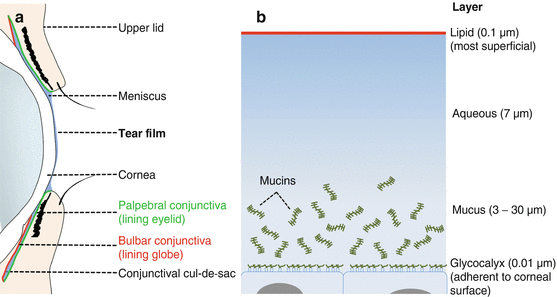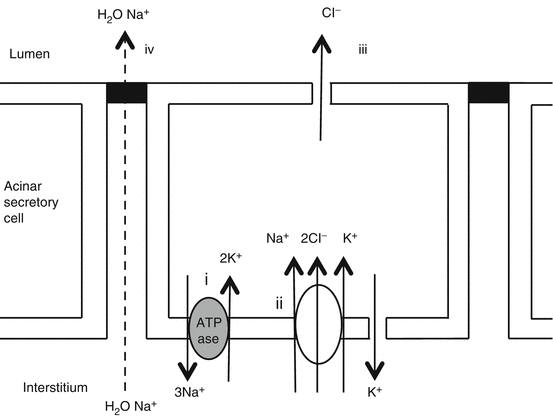(1)
University of Sydney, Sydney, Australia
The Tear Film
Overview (Fig. 2.1a)

Fig. 2.1
The tear film (a) distribution; (b) structure
The tear film is a highly ordered fluid layer lining the cornea and bulbar and palpebral conjunctiva.
Abnormal constitution or volume impairs the ocular surface and may reduce corneal transparency [1].
1.
Optical
The tear film provides a smooth, regular optical surface for refraction, filling corneal irregularities [3].
The air-tear film interface is the most powerful refractive surface of the eye.
2.
Mechanical
The tear film adheres to the bulbar and palpebral conjunctiva ensuring well-lubricated surfaces [2].
Blinking flushes debris and exfoliated cells from the ocular surface out through the tear duct.
3.
Nutritional
Oxygen dissolves in the tear film from air, supplying the avascular cornea [4].
Nutrients (e.g., glucose) pass from the conjunctival vessels to the cornea via the tear film.
Distribution and Flow of Tears
The tear film has a total volume of 7–10 μL.
70–90 % reside in the upper and lower tear menisci. These are curvilinear collections of tears that line the ocular surface immediately adjacent to the lid margins.
The tear film drains via the menisci through the lacrimal puncta which are apposed to the globe near the inner canthus (See Figs. 2.2 and 2.5a) [7].

Fig. 2.2
Structure of the lacrimal gland
Tears are also stored in the upper and lower conjunctival cul–de–sacs (fornices).
Normal basal tear production rate is 1–2 μl/min; in contrast the reflex tear rate is >100 μl/min [8].
Normal tear volume turnover occurs every 5–7 min.
Structure of the Tear Film [9, 10] (Fig. 2.1b)
From superficial to deep:
Lipid layer (0.1 μm)
Aqueous layer (7 μm)
Mucous layer (3–30 μm)
Glycocalyx (0.01–0.02 μm)
Lipid Layer
1.
Composition, origin, and function (See Fig. 1.2)
The lipid layer consists of hydrocarbons, sterol esters, waxy esters, triglycerides, free cholesterol, free fatty acids, polar lipids and proteins [11].
It is primarily secreted from meibomian glands with additional contributions from the glands of Moll and Zeiss [12, 13].
It is emitted as a liquid spreading over the aqueous on blinking.
Polar lipids form the inner surface of the lipid layer, with their charged side facing aqueous [14, 15].
Nonpolar lipids spread over the polar lipids.
The lipid layer:
(a)
Inhibits evaporation of underlying aqueous.
(b)
Maintains tear film stability.
(c)
Prevents contamination with skin lipids (which can destabilize the aqueous).
2.
Meibomian glands
Meibomian glands are tubuloacinar glands, 20–30 per tarsus in number, embedded in the upper and lower tarsal plates.
Lipid-laden acinar cells burst apically releasing their lipid-rich vesicles into the acinar space.
The release of the entire cell contents is known as holocrine secretion, resulting in a mixture of proteins and lipids termed meibum [11].
3.
Regulation of meibum secretion
(i)
Neural regulation
Meibomian glands are innervated richly by sensory, sympathetic, and parasympathetic nerves [19].
However, how these nerves regulate meibum secretion is unknown.
(ii)
4.
Glands of Moll
These modified sweat glands open into the eyelash hair follicle, producing secretions rich in proteins and lipoproteins [24].
5.
Glands of Zeiss
These are rudimentary sebaceous glands, similar in structure and secretion to Meibomian glands [25].
Their ducts open at the lid margin or into eyelash follicles.
Aqueous Layer
1.
2.
Composition
The aqueous contains solutes essential for epithelial integrity.
Regulation of tear pH and osmolarity is essential for optimal epithelial cell function and survival.
(i)
(ii)
Tear osmolarity
Tear osmolarity is lower during closure overnight due to reduced evaporative loss.
During the day, tear osmolarity stabilizes like pH [30].
(iii)
Protein constituents
Some of the major protein constituents of the aqueous are outlined in Table 2.1.
Protein class
Examples
Function
Antibacterial agents
Secretory immunoglobulin A
Binds and opsonizes foreign antigen
Lysozyme
Damages bacterial cell walls
Lactoferrin
Binds free iron, inhibiting bacterial proliferation
Wetting agents
Lipocalin
Promotes surface wettability, allowing the tear film to spread uniformly over the corneal and conjunctival surfaces
Growth factors
Lacritin
Promotes epithelial renewal
Mucus Layer and Glycocalyx
1.
Composition
The mucus layer consists of:
(a)
Mucins (glycoproteins) secreted by conjunctival goblet cells
(b)
Water and electrolytes secreted by conjunctival goblet and non–goblet epithelial cells
Mucins are high molecular weight proteins with many carbohydrate side groups.
2.
Storage and secretion
Mucin is stored in large secretory granules at apical surface of goblet cells.
Neuronal control of secretion allows mucin release in response to surface irritation or microtrauma.
Goblet cells are not directly innervated, but cholinergic (acetylcholine (ACh) and vasoactive intestinal peptide (VIP)) and adrenergic (noradrenaline) neurotransmitters diffuse from the surrounding vascular and subepithelial conjunctival autonomic plexuses [37].
Cholinergic neurotransmitters provide the predominant goblet cell stimulation [38].
Water and electrolytes are secreted across all conjunctival cells using basolateral Na +/K + ATPase pump activity, with water being transported transcellularly by aquaporins [39, 40].
3.
Functions
(i)
Mucin
(a)
Enhances lubrication, allowing the palpebral and bulbar conjunctiva to slide over each other with minimal trauma during blinking or eye movements [42].
(b)
Protects the epithelial surface; it spreads rapidly to heal defects and cover foreign bodies.
(c)
Acts as reservoir for immunoglobulins.
(d)
Promotes surface wettability by overcoming corneal epithelial hydrophobicity.
Lacrimal Gland
Overview
The lacrimal gland secretes the major portion of the aqueous layer of the tear film.
Structure
1.
2.
Tubuloacinar structure
The lacrimal gland is a lobulated tubuloacinar gland.
Multiple acini drain into progressively larger tubules which drain into the superolateral fornix [47].
The acini consist of columnar secretory cells.
Myoepithelial cells basal to secretory cells have contractile properties to help express secretions.
The acini are surrounded by an interstitium with a dense network of capillaries and immunological cells (macrophages, eosinophils, lymphocytes, and plasma cells) [48].
Plasma cells produce IgA that is secreted in tears [48].
Lacrimal Gland Secretion
Lacrimal gland secretion forms most of the aqueous component of the tear film. Constituents include:
1.
3.
Metabolic pump
(i)
Intracellular Na+ is depleted.
(ii)
This encourages entry of Na+, K+, and Cl− via a cotransporter.
(iii)
This causes a net movement of Cl− across the cell into the lumen of the acinus.
(iv)
Paracellular Na+ and water movement result in secretion of fluid.
Control of Lacrimal Gland Secretion
The lacrimal gland is innervated by parasympathetic and sympathetic fibers.
1.
Parasympathetic innervation
2.
Sympathetic innervation
Sympathetic fibers have a minor role in controlling lacrimal gland secretion.
These use noradrenaline to stimulate α- and β-adrenergic receptors on lacrimal secretory cells [54].
Stimulation results in constriction of local blood vessels and contraction of myoepithelial cells.
3.
Reflex tear secretion
Reflex tear secretion occurs through peripheral or central stimulation.
Peripheral sensory stimulation (e.g., of the cornea, conjunctiva, nose, or midfacial skin) is mediated by the trigeminal nerve as the afferent arm [47, 55].
Central stimuli may be related to light (optic nerve as afferent arm) or emotion (e.g., weeping).
The parasympathetic and sympathetic nerves are efferent arms of the reflex arc [47].
Conjunctiva
Overview
The conjunctiva, together with the corneal epithelium, forms the ocular surface. Functions include:




